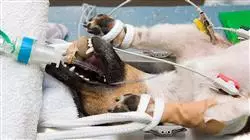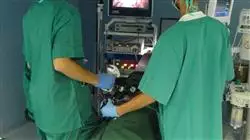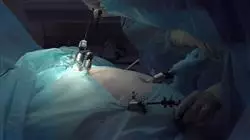University certificate
The world's largest faculty of veterinary medicine”
Description
This postgraduate diploma, offered in a 100% online modality, will enable you to combine your studies while increasing your knowledge in this field”

Minimally Invasive Techniques for the Diagnosis and Treatment of various diseases in small animals were first implemented in veterinary medicine 20 years ago and have had exponential growth in the last decade.
This upturn, which goes hand in hand with the progress made by human medicine in the field, is owed to several factors: technical development, equipment and instruments that offer higher quality images and are more affordable; the development of specific diagnostic and therapeutic techniques, as well as of professionals who are better trained and carry out most of their clinical activities through these minimally invasive techniques, in addition to owners who are ever more concerned about the health of their pets and demand more specialized clinical services, more accurate clinical diagnoses and treatments that are less invasive and that will result in lower pain levels and fewer hospitalizations for their pets.
The faculty of this program is at the forefront of the latest diagnostic techniques and treatment of cardiovascular diseases in small animals. Thanks to their specialized training, they have developed a useful and practical program that is adapted to the current reality, a reality that is becoming more and more demanding and specialized.
The teaching team has selected an agenda that generates specialized knowledge with an overview of the importance of minimally invasive techniques for the diagnosis and treatment of many diseases affecting small animals, in the description of equipment, instruments, approaches in minimally invasive surgery, anesthesia and most frequent complications.
It provides high quality multimedia material on different laparoscopic and thoracoscopic surgical techniques, from the simplest and most common to the most technically complex. It also addresses, in detail, diagnostic and therapeutic techniques as used in Rigid and Flexible Endoscopy.
As it is an online postgraduate diploma course, students are not restricted by set timetables, nor do they need to physically move to another location. All of the content can be accessed at any time of the day, so you can balance your working or personal life with your academic life.
This training is the best option you can find to specialize in Laparoscopy and Thoracoscopy in Small Animals and make more accurate diagnoses"
This postgraduate diploma in Laparoscopy and Thoracoscopy in Small Animals contains the most complete and up to date educational program on the market. The most important features of the program include:
- Case studies presented by experts in Laparoscopy and Thoracoscopy in Small Animals
- The graphic, schematic, and practical contents with which they are created provide scientific and practical information on the disciplines, essential for professional development
- Latest information on Laparoscopy and Thoracoscopy in Small Animals
- Practical exercises where self assessment can be used to improve learning
- Its special emphasis on innovative methodologies in Laparoscopy and Thoracoscopy in Small Animals
- Theoretical lessons, questions to the expert, debate forums on controversial topics, and individual reflection assignments
- Content that is accessible from any fixed or portable device with an Internet connection
This postgraduate diploma is the best investment you can make when choosing a refresher program to expand your knowledge on Laparoscopy and Thoracoscopy in Small Animals”
Its teaching staff includes professionals belonging to the field of Veterinary Surgery who bring to this training the experience of their work, as well as renowned specialists from reference societies and prestigious universities.
The multimedia content, developed with the latest educational technology, will provide the professional with situated and contextual learning, i.e., a simulated environment that will provide immersion training programmed to train in real situations.
This program is designed around Problem Based Learning, whereby the professional must try to solve the different professional practice situations that arise throughout the program. For this, the professional will have the help of an innovative interactive video system designed by recognized experts in Veterinary Surgery.
Don’t miss the opportunity to complete this course in Laparoscopy and Thoracoscopy in Small Animals with us. It's the perfect opportunity to advance your career”

Veterinarians must continue their training to adapt to new developments in this field”
Objectives
This program in Laparoscopy and Thoracoscopy in Small Animals is designed to facilitate the performance of the veterinary professional with the latest advances and most innovative procedures in the field.

It is the best option to learn about the latest advances in Laparoscopy and Thoracoscopy in Small Animals”
General Objectives
- Analyze the history, evolution and new perspectives of minimally invasive techniques
- Detail basic and accessory equipment and instruments used in laparoscopies with small animals
- Compile a list of the techniques needed to perform laparoscopic surgery
- Develop a training program for laparoscopic surgery
- Analyze the importance of ergonomics in laparoscopic surgery
- Provide students with a detailed description of minimally invasive techniques used with diseases in the reproductive system and in endocrine, splenic and extrahepatic vascular surgery
- In depth study of the indications of minimally invasive techniques versus standard techniques, as used with diseases in the reproductive system and in endocrine, splenic and extrahepatic vascular surgery
- In depth study of the advantages and disadvantages of minimally invasive techniques, as used with certain diseases in the reproductive system and in endocrine and splenic surgery
- Analyze the therapeutic advantages of new modalities of minimal invasion in the treatment of extrahepatic portosystemic shunt
- Integrate the knowledge acquired in these new therapeutic modalities to obtain a global vision of diseases in the reproductive system, and of endocrine, splenic and extrahepatic vascular surgery
- Provide the Veterinary Clinic with the knowledge required to perform laparoscopic techniques on the urinary and digestive systems
- Perform in depth examination of port placement and patient positioning for laparoscopic techniques used with urinary and digestive tracts
- Integrate knowledge in such a way that will allow students to gain confidence and assurance when performing laparoscopic interventions in the urinary and digestive systems
- Examine the advantages and disadvantages of using minimally invasive techniques in urinary and digestive systems, as compared to more conventional methods
- Provide students with the general surgical knowledge required to minimize perioperative complications during laparoscopic surgery of the urinary and digestive systems
- Analyze indications and patient selection process for laparoscopic cholecystectomy
- Incorporate newly acquired knowledge in order to determine optimal therapeutic treatment for inguinal and perineal hernias
- Develop an understanding of thoracoscopic approach techniques and address the main complications that may occur
- Describe techniques most frequently used in thoracoscopic surgery
- Integrate the student's knowledge which will allow them to gain confidence and a sense of security in the interventions developed in this module
Specific Objectives
Module 1. Basic Principles in a Laparoscopy
- Analyze the history and evolution of minimally invasive surgical techniques
- Establish the basic equipment and instruments needed to perform a laparoscopy
- Identify complementary material used to perform laparoscopies, such as electrosurgical units
- Develop a training program to gain the skills needed to perform laparoscopy surgery
- Evaluate the different techniques used in the laparoscopic approach to surgery
- Identify the different complications that could arise with the laparoscopic technique
- Analyze new perspectives in laparoscopy surgery, such as single incision laparoscopy and NOTES
Module 2. Laparoscopic Techniques for the Reproductive, Endocrine, Splenic and Portosystemic Shunt Systems
- Develop minimally invasive techniques for procedures on the female reproductive system, such as sterilization techniques, treatment of ovarian remnants and the excision of ovarian tumors
- Analyze the techniques and indications for minimally invasive insemination
- Identify the laparoscopy technique for abdominal cryptorchidism
- Describe technique and patient selection process in laparoscopic adrenalectomy
- Demonstrate laparoscopy techniques used to perform pancreatic biopsy and pancreatectomies
- Analyze minimally invasive techniques used for attenuation of the portosystemic shunt
- Address the technique and patient selection process in laparoscopic surgery for performance of a splenic biopsy and a splenectomy
Module 3. Laparoscopic Techniques for the Urinary and Digestive systems
- Develop knowledge of minimal invasion techniques for performing a laparoscopy assisted cystoscopy
- Analyze the laparoscopy techniques and indications of renal biopsy
- Examine laparoscopy techniques for a ureteronephrectomy and renal cyst omentalization
- Describe advanced laparoscopic techniques as applied to the urinary system, such as ureterotomy, urethral reimplantation, and insertion of an artificial bladder sphincter
- Present the laparoscopic techniques, indications and complications involved in a liver biopsy and hepatectomy
- Demonstrate laparoscopy techniques used to perform preventative gastropexies in dogs
- Describe the laparoscopy technique as used to examine the digestive system and the removal of foreign bodies from dogs
Module 4. Laparoscopic Techniques in Extrahepatic Biliary Tree, Inguinal and Perineal Hernias. Thoracoscopic Techniques.
- General, Pericardium, Pleural Effusion, Vascular Rings, and Mediastinal Masses
- Develop techniques and establish a patient selection protocol to perform a cholecystectomy
- Identify the laparoscopy technique for the resolution of an inguinal hernia
- Examine minimal invasion techniques as part of treatment of perineal hernias
- Develop an understanding of the indications, approach techniques and complications involved when performing a thoracoscopy in small animals
- Describe thoracoscopic techniques for performing pericardiectomies in dogs
- Review indications for lung biopsies and lobectomies and develop the thoracoscopic technique to perform these
- Describe the thoracoscopic technique as it used to correct a right aortic arch in dogs
- Review the different surgical options, including thoracoscopies, used to excise surgical masses

A path to achieve professional growth that will propel you towards a greater level of competitiveness in the job market"
Postgraduate Diploma in Laparoscopy and Thoracoscopy in Small Animals
.
If you are a veterinary professional passionate about small animal medicine and wish to specialize in advanced diagnostic and treatment techniques, we invite you to discover our Postgraduate Diploma program in Laparoscopy and Thoracoscopy in Small Animals, offered online by TECH Global University. Currently, laparoscopy and thoracoscopy are fundamental tools in veterinary practice, allowing minimally invasive procedures with multiple benefits for patients. These techniques have revolutionized the field of veterinary surgery by reducing surgical trauma, speeding recovery and improving clinical outcomes.
Enroll now and start online
.
Our Postgraduate Diploma program will provide you with the theoretical and practical knowledge necessary to master these techniques in the context of small animal medicine. Through a combination of didactic content, video demonstrations, hands-on sessions and assessments, you will develop the skills necessary to perform laparoscopy and thoracoscopy with precision and safety. By studying online, you will have the flexibility to access the study material from anywhere at any time. Our program has been carefully designed to provide you with an interactive and enriching learning experience, with the support of an expert teaching team in the field of minimally invasive small animal surgery. At TECH Global University, we are proud to offer a quality education that combines theory and practice to prepare highly trained professionals. Our goal is to provide you with the tools you need to excel in your veterinary career and make a difference in the health and welfare of animals. Don't miss the opportunity to become an expert in small animal laparoscopy and thoracoscopy! Join TECH Global University and acquire the skills that will enable you to provide state-of-the-art veterinary care.







